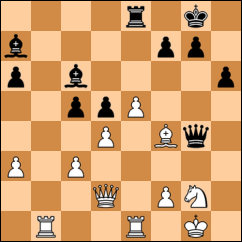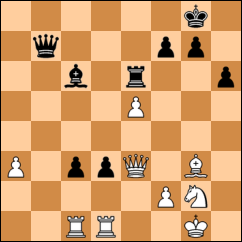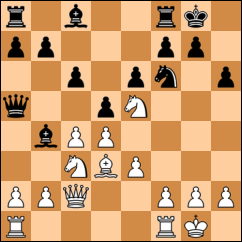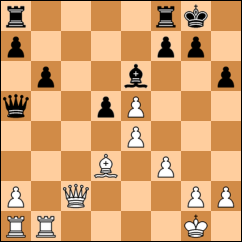S.McWhirter–G.Sargent
Route 20 Chess Club
Freeport, Illinois, Aug. 24, 2010
1.e4 e5 2.Nf3 Nf6 3.Nc3!?
When I saw those first couple of moves, I was hoping for a Petrov, but no such luck.
3...Nc6 4.Bb5 a6 5.Bxc6 bxc6?!
5...dxc6 offers much better chances.
6.Nxe5 Bb4 7.d3 0-0 8.0-0 Bb7
8...Re8 9.f4 Bb7 looks better.
9.Be3 d6 10.Nf3 h6 11.Re1 Qd7 12.h3 Rae8
It's not pretty, and Steve is a pawn up, but Gary has managed to complete his development first.
13.a3 Ba5 14.b4 Bb6 15.d4
Preparing to push the e-pawn. But this is careless: 15...Nxe4 16.Nxe4 Rxe4 wins black's pawn back.
15...Re6 16.e5 Nd5 17.Nxd5 cxd5
The doubled pawns on the d-file are much less of a liability than they were on the c-file. Imagine that Steve now decides he wants to move his knight to a more active position. He can't do it: c4, e4, a5 and c5 are all off-limits to him now. The only path forward is Nh4-f5, and as soon as he makes the first move, Gary can shut it down with g6, leaving Steve's knight without options.
18.Bf4 Rfe8 19.Qd2
Finally, Steve is fully developed, but his position is awful. What can he do from here?
19...c5 20.bxc5
Better to strike at the defending pawn first: 20.exd6 cxd4 21.Rxe6 Qxe6 22.Re1 (not the more dispersed 22.Nxd4 Qf6 23.Nb3 Bc6).
20...dxc5 21.Rab1 Ba7 22.c3 Bc6 23.g4?!
A dubious move that disregards the potent threat of ...c4, which will allow black to come roaring down the queenside.
23...Rg6
Luckily for Steve, Gary doesn't seem to be thinking that way. But his advantage, despite being a pawn up, has narrowed significantly.
24.Nh4
A shrewd and subtle defensive move. Now if Gary tries to bash through with Rxg4+?? -- which would have worked just a moment ago -- Steve interposes his knight and bats the threat away effortlessly. Having driven Steve's knight to the edge of the board, Gary's best move is simply to pull the rook back where it came from.
24...Rxg4+??
Uh-oh. Gary goes for it anyway.
25.hxg4 Qxg4+ 26.Ng2
Steve is out of immediate danger and has won a rook for a pawn. But he still has to get his balance back; his knight is pinned, and his pieces aren't working together.
26...Re6 27.Qe2
27.Re3 is better, setting up Rg3. Pulling the queen off d2 allows Gary to desperado his queen in order to gain back a pawn: 27...Qxe2 28.Rxe2 cxd4 29.cxd4 Bxd4.
27...Qg6
Gary misses that the desperado move is actually mandatory, as his a-pawn is hanging and under attack, and his dark-square bishop is trapped in the corner, where it will be next to fall.
28.Qxa6 cxd4
Not much else to do, since the bishop is toast.
29.Qxa7 dxc3 30.Rbc1
30.Rb8+ is a sledgehammer blow, setting up a potential mating combination on the back row, though one that will take a few moves. Steve's actual move, meanwhile, overlooks a nasty attacking combination from Gary. What's the black move that releases the hounds? (Highlight to reveal answer.)
30...d4 threatens ...Qxg2#. If Steve plays any response other than 31.Bg3, at best his material advantage is demolished (e.g., 31.f3 Bxf3 32.Re2 Bxe2 33.Qxd4 c2), and at worst, he loses outright. Fortunately, Steve finds the one response that lets him hold onto his winning advantage: 31.Bg3 Qd3
32.Re3?
Recognizes the re-energized mating threat -- but why put a rook where it can be taken by a pawn? 32.Kh2 is actually sufficient to neutralize it. Now 32...Qf3 is easily sidestepped by 33.Nh4, after which both potential invasion squares are defended and the queen is counterattacked to boot.
32...Qd2
A bit of a gift, as you can't really fork two rooks when one can move to defend the other. 33.Rexc3 gobbles up a pawn on the way to the afterlife, and 33...dxc3 34.Qe3 keeps the other rook from being lost.
33.Ree1??
Allows Gary to reactivate the threat of ...Qd3. Plus, by repeating the position, Steve runs the risk of a threefold draw. This is a tightrope walk.
33...d3??
For whatever reason, Gary gives up on his combination attack. It can't be that he thinks Steve will seek the repetition draw, can it?
34.Red1
Nope, better to just kick Gary's queen in the face.
34...Qb2 35.Qe3 Qb7
It's just not the same with the queen in back rather than in front . . .
36.Rxc3
. . . but that doesn't mean there's nothing at all to it. Steve overlooks the threat to his knight, allowing Gary to pick it off. He has a swellegant alternative in 36.Nf4!, which cleverly forks Gary's rook and one of the paired pawns. Gary can buy time with 36...c2, but all Steve has to do is advance his rook with 37.Rd2, corking the other pawn and holding it in place to be picked off after Gary evacuates his rook with 37...Re8. The c-pawn must abandon all hope as well. It's a beautiful cascade of seemingly predestined moves.
36...Bxg2
In contrast, the loss of the knight is as ugly as a skinned palm from falling down in your own driveway.
37.Rcxd3 Bh1 38.f3
Nice try, Gary.
38...Rg6 39.Rd8+
Assertive, but Steve isn't out of the woods yet. 39.Kh2 allows Steve to relax, as there's nowhere for that bishop to go.
39...Kh7 40.Qe4
Does Steve not realize his bishop is hanging? Or, for that matter, that Gary's bishop is hanging? Either 40.Kf2 or 40.Kxh1 is practically mandatory.
40...Qxe4 41.fxe4 Bxe4
Batmobile lost a wheel, Joker got away. Steve's hopes now rest entirely on his extra rook and his a-pawn. Can he convert these advantages into a win? It's pure endgame now, and you can never count Gary out in such a situation.
42.Kh2 Rc6 43.R1d6 Rc2+ 44.Kh3
The more assertive 44.Rd2 forces black to reassess his priorities. 44...Rc3 45.Rf2 Rxa3 46.Rxf7 sacrifices the a-pawn and transfers its aspirations to the e-pawn, which is better suited to fulfill them anyway. And should Steve's king really be hanging around on light squares?
44...Bf5+ 45.Kh4 Rc3 46.Kh5??
Leaving the bishop to die. That's cold, man. And moving onto another light square . . . Steve's king is living dangerously.
46...Rxa3
If 46...Rxg3, it's all over, because of the threat of 47...Rh3#. White's moves are forced: 47.Rxh6+ gxh6 48.Rd4 (preparing to block check) Rxa3, and now it's black who's a piece and a pawn ahead. White is in no position to keep black from picking off his e-pawn (49.Rh4 Ra5 50.Rf4 Rxe5; 49.Rf4 (or 49.Rb4) Rh3+ 50.Rh4 Re3 51.Rf4 Rxe5).
Self-preservation would seem to dictate 47.Kh4, getting onto a dark square and defending the bishop, which Gary has magnanimously spared. Alternatively, Steve might play 47.Rf8 first, followed by 47...g6+ 48.Kh4. Either line will progress into a series of checks that ultimately amount to an equalization of pieces, after which Steve and Gary can get down to the business of agreeing to a draw. (One possible line: 47.Rf8 g6+ 48.Kh4 Ra4+ 49.Bf4 g5+ 50.Kg3 gxf4+ 51.Kf3 Be6 52.Rxe6 fxe6 53.Rf6 Kg7 54.Rxe6=.)
But self-preservation isn't on Steve's agenda.
47.Bf4?? 48.Rh3# 0-1


















